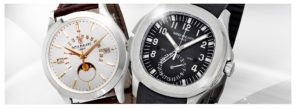
Asking a Patek Philippe collector to pick their top 10 references is akin to asking a parent to name their favorite child. It’s a fundamentally unfair question because every Patek has admirable and desirable traits. When pressed, however, everyone has their favorites.
Please note that if you ask us again later, the list may have changed! Tastes and fashions change throughout time, which is why Patek’s historical production is so fascinating to investigate.
The significant part is that you may buy an example from this list for as little as $10,000 or as much as $1 million or more for unique examples of these references.
Patek Philippe, Ref. 570Original 1938
This is the perfect Patek beginning a piece for you if you’ve never worn an older watch before. It’s a comfortable size at 35 mm, and the stylistic options for this famous design are unlimited.
This manually wound three-hand watch, produced in around 2,000 specimens in yellow, rose, and white gold, as well as platinum and two-tone between 1938 and 1972, is at the top of the list for relative affordability and wearability.
Patek Philippe, Ref. 1463
The Patek Philippe watch model 1463 was the first mass-produced water-resistant chronograph, with around 800 pieces made in yellow and pink gold and steel between 1940 and 1969. This 35 mm sports watch has a screwback case and dust cover, making it a comfortable and practical antique watch to wear. Prices range from $10,000 to $500,000 for uncommon variations in excellent condition.
Patek Philippe, Ref. 1518
This is a grail item for those wanting to put together a vertical collection of Patek Philippe perpetual calendar chronographs, as it was only made in 281 copies from 1941 to 1954.
It is the first perpetual calendar chronograph ever produced in series by any watchmaker, and it has remained so for nearly 40 years. The design of 1518 served as a prototype for Patek Philippe’s perpetual calendar lineage, which included 2499, 3970, 5970, and now the 5270.
Trying to find 1518 in excellent form can be a global treasure hunt, as most big collectors already have one and are on the lookout for even better-preserved copies.
About half of those ever created have already appeared on the market, so there is usually a lot of anticipation when a new one seems. If you can, get one immediately.
Patek Philippe, Ref. 2526
No other mid-century watch achieves such a subtle balance of artistic beauty and technical prowess. Patek Philippe’s first regular production automatic watch, introduced in 1953, dominated the premium time-only market in the mid-1950s.
Approximately 3,000 specimens were constructed in four different case metals, with porcelain enamel dials and attached gold batons used on the vast majority of these references.
Many believe the caliber 12-600 AT to be one of the most aesthetically pleasing wristwatch movements ever created, and it was housed in a 35.5 mm water-resistant case.
Buyer beware: obtaining 2526 with a dial-in in excellent condition is difficult due to the fragility of the porcelain enamel glass dials. Expect to pay $50,000 for a perfect yellow gold example, and it only gets more expensive from there.
Patek Philippe, Ref. 3417
Between 1959 and 1968, approximately 500 instances of the steel anti-magnetic reference 3417 were produced. This 35 mm watch was designed as a tool watch for scientists and engineers who work in environments where strong magnetic fields can degrade a watch’s ability to keep time.
It combined cutting-edge technology with a straightforward design that made it as fashionable then as it is now. If the term “oersted” — a unit of magnetic field strength, in case you didn’t know — comes up at your next dinner party, this is the watch for you.
Patek Philippe, Ref. 3448
At the time of its introduction, the 3448 was the only self-winding perpetual calendar produced by any manufacturer. Thanks to its clean, modern display and conspicuous moon-phase indication, it would be the gentleman’s timepiece of choice for the following 20 years.
Only 586 examples were manufactured between 1962 and 1985, the majority in yellow or white gold, two in platinum, and a few in rose gold. Seven of the 586 originals were later changed to remove the moon-phase disk. Only one of the seven was converted to reflect the leap year.
The complex procedure was carried out in 1975 at the request of Patek Philippe’s proprietors, Henri and Philippe Stern, as indicated by the ‘AB’ on the case back.
It was a present for Alan Banbury, the company’s influential director of sales for English-speaking countries and the custodian of the private collection that would eventually become the Patek Philippe Museum, on the occasion of his tenth year on the job.
As a result, the Alan Banbury 3448J stands out from the rest of the 3448s. It is projected to establish a new auction record for reference when it goes up for auction on May 22.
Takeaway
It’s heartening to see that, in this digital age, where time can be checked on several gadgets, the precision engineering and quality of these luxurious timepieces can still command high prices. Patek Philippe watches, such as the Patek Philippe Henry Graves, not only provide a tried-and-true method of telling time but also a feeling of art, making them some of the most sought-after timepieces.
